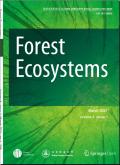在从老林地到成熟温带森林的演替过程中,土地利用的遗留影响了树种的组成和分布及其地下功能
IF 4.4
1区 农林科学
Q1 FORESTRY
引用次数: 0
摘要
在美国和欧洲的温带地区,因农业用途而被遗弃的森林(即老田)正在经历生态演替,这种情况比比皆是。旧田地的生态演替涉及植被组成的变化,受土地使用历史、土壤条件和扩散限制等因素的影响。物种的行为、形态、生理和生活史属性会影响环境和生物过滤器对物种分布和数量的影响。然而,许多研究都集中于地面属性,而较少关注影响群落组合和功能的地下物种特征。在这项研究中,我们采用了一种基于性状的方法,来研究地上植物的组成和分布如何随植物根系功能性状(如菌根关联)的变化而变化,而植物根系功能性状会介导氮(N)和磷(P)等养分的获取。我们清查了一个 10 公顷林地中的每一棵树的茎干(n = 11551),其中包括旧田地森林和历史森林,并将每个物种与现有数据库中的根系功能特征(n = 33)进行匹配。我们发现,土地使用历史影响着老林场森林的群落组成和分布,而群落组成和分布也随地下根系功能特征的变化而变化。旧田地森林中的群落组成以槭树和非本地物种为主,这在很大程度上与丛生菌根(AM)和较高的根营养浓度有关。另一方面,历史森林中的群落组成(主要以红豆杉(Tsuga canadensis)为主)与外生菌根(EcM)以及根长和根深的更多变化有关。这些结果表明,地上群落的变化对地下生态系统服务(如养分循环)有影响,而地下生态系统服务对森林生态系统的发展非常重要。基于性状的方法可以阐明群落组合的机制,了解性状如何影响物种共存和相互作用,可以为受干扰或改变的森林中生物多样性保护和恢复工作的相关管理决策提供信息。本文章由计算机程序翻译,如有差异,请以英文原文为准。
Land-use legacies affect the composition and distribution of tree species and their belowground functions in a succession from old-field to mature temperate forest
Forests undergoing ecological succession following abandonment from agricultural use (i.e., old fields) are ubiquitous in temperate regions of the U.S. and Europe. Ecological succession in old fields involves changes in vegetation composition influenced by factors such as land-use history, soil conditions, and dispersal limitations. Species’ behavioral, morphological, physiological and life-history attributes influence the outcomes of environmental and biotic filters on distribution and abundance. However, many studies have focused on aboveground attributes, while less attention has been placed on belowground species characteristics that influence community assembly and function. In this study, we used a trait-based approach to examine how aboveground plant composition and distribution vary with plant root functional traits (e.g., mycorrhizal association) that mediate access for nutrients such as nitrogen (N) and phosphorous (P). We inventoried every tree stem (n = 11,551) in a 10-ha forested area containing old-field and historical forests and matched every species with root functional traits (n = 33) from established databases. We found that land-use history influences community composition and distribution in old-field forests, which also varied with belowground root functional traits. Community composition in old-field forests, which were dominated by Acer saccharum and non-native species, were largely associated with arbuscular mycorrhizae (AM) and higher root nutrient concentrations. On the other hand, community composition in historical forests – largely dominated by Tsuga canadensis – were associated with ectomycorrhiza (EcM) and more variation of root length and depth. These results suggest that changes in aboveground communities have implications for belowground ecosystem services (e.g., nutrient cycling) which are important to forest ecosystem development. Trait-based approaches can elucidate mechanisms of community assembly, and understanding how traits influence species coexistence and interactions can inform management decisions related to biodiversity conservation and restoration efforts in disturbed or altered forests.
求助全文
通过发布文献求助,成功后即可免费获取论文全文。
去求助
来源期刊

Forest Ecosystems
Environmental Science-Nature and Landscape Conservation
CiteScore
7.10
自引率
4.90%
发文量
1115
审稿时长
22 days
期刊介绍:
Forest Ecosystems is an open access, peer-reviewed journal publishing scientific communications from any discipline that can provide interesting contributions about the structure and dynamics of "natural" and "domesticated" forest ecosystems, and their services to people. The journal welcomes innovative science as well as application oriented work that will enhance understanding of woody plant communities. Very specific studies are welcome if they are part of a thematic series that provides some holistic perspective that is of general interest.
 求助内容:
求助内容: 应助结果提醒方式:
应助结果提醒方式:


